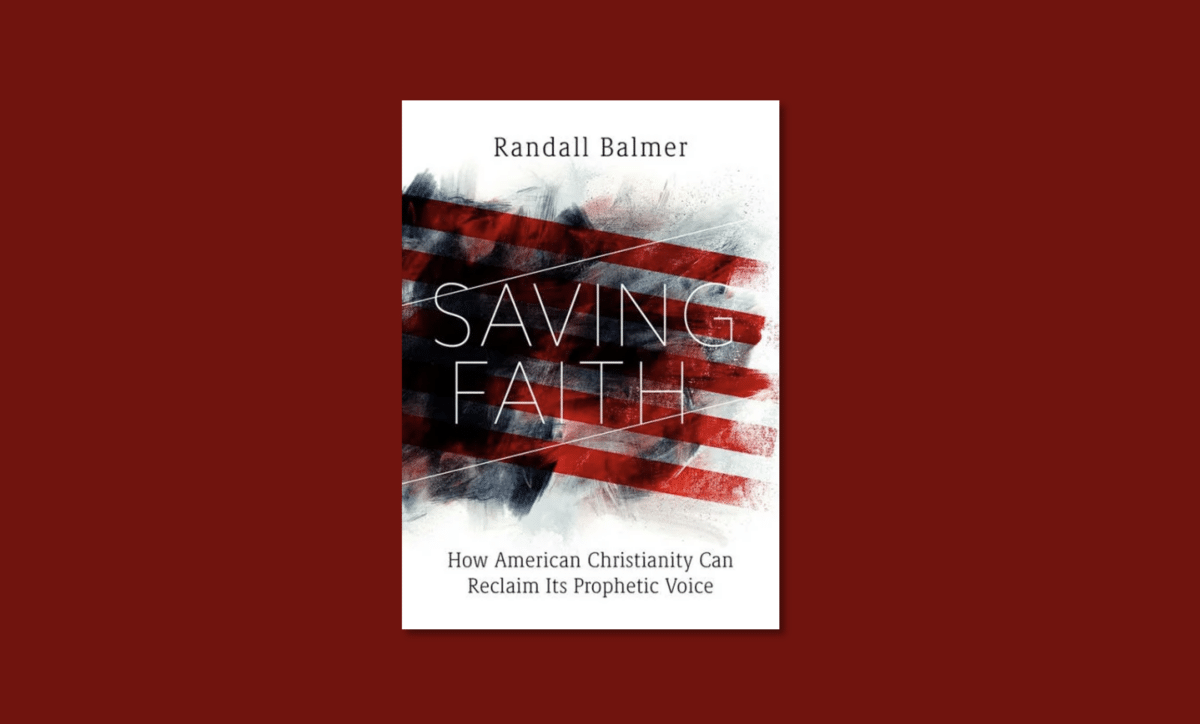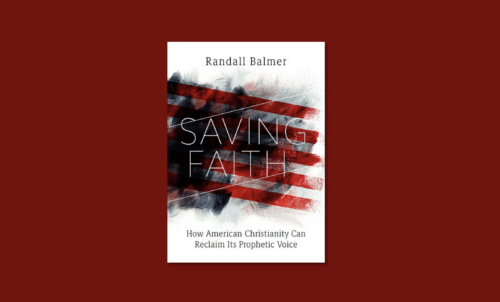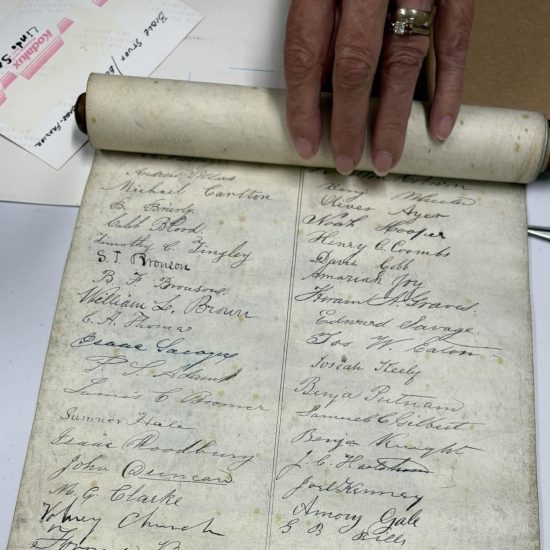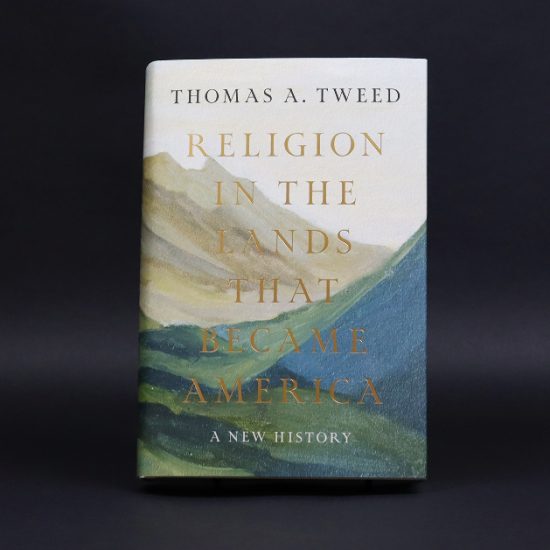

SAVING FAITH: How American Christianity Can Reclaim Its Prophetic Voice. By Randall Balmer. Minneapolis, MN: Fortress Press, 2023. Xv + 104 pages.
Christian Nationalism is on the rise in the United States, but it isn’t just an American issue. We’re seeing forms of Christian Nationalism rise up in many places, especially in Eastern Europe. There are connections between forms of Christian Nationalism in places like Hungary and Russia and forms found in the United States. Even as Christian Nationalism is gaining strength in certain circles, there are also movements of resistance, especially among Mainline Protestant Churches. Being that I am a Disciples of Christ minister, serving on our General Board and a voting representative to our General Assembly, I can point to a resolution approved at the 2023 General Assembly of the Christian Church (Disciples of Christ) that called for our churches to stand in opposition to Christian Nationalism. Since the Disciples of Christ is a binational denomination, we took note of Christian Nationalist movements in both the United States and Canada. A growing number of books have gone to print in recent years addressing this movement. I’ve read some of these books and there are several others that I am eager to read and possibly review. Several books have been written addressing this issue, some of which I’ve read, others I want to read. It is good that voices are being raised, voices that offer sound, analytical reflections, calling for Christians to take a deep look at our susceptibility to such movements.

Robert D. Cornwall
Among the recent books addressing this growing phenomenon is Randall Balmer’s brief book titled Saving Faith: How American Christianity Can Reclaim Its Prophetic Voice. Despite its brevity, or perhaps because of its brevity, it offers an effective call to American Christians, especially evangelical Christians, to reclaim a prophetic voice. Balmer is a religious historian who teaches American religion at Dartmouth College, after spending many years teaching at Columbia University. Balmer writes to a community he once called home (and one I once called home). Like many of us who find ourselves post-evangelical, Balmer conveys the sense of loss that he feels due to what he sees happening to contemporary evangelicalism. That is especially true of white evangelicalism. In many ways this is a word to the church and Christianity at large, because many Mainline Protestants share similar beliefs and practices as non-Mainline evangelicals, acknowledging the decline in our fortunes and the realities of racism in the church and nation.
I must note here that Balmer writes this book from a Christian perspective. That is, he is a professing Christian who grew up in the Evangelical Free Church and graduated from an evangelical college and seminary (Trinity University and Trinity Evangelical Divinity School). He writes that he grew up in the evangelical subculture, the son of an Evangelical Free Church pastor. He writes in his preface, “I’ll put up my credentials as an evangelical up against anyone—including Franklin Graham, by the way, although I concede that his father, Bill Graham, might have been a bit more famous than mine” (p. xiv). While he has the evangelical credentials, he has drifted away from that world, largely because he was tired of the “pitched, vicious, internecine battles over such issues as biblical inerrancy that I witnessed in seminary” (p. xiv). I probably lasted a bit longer as I went to Fuller Seminary, where the battles over inerrancy had largely been set aside, unlike at Trinity. While his current evangelical identity might be questioned (as is true for me), Balmer insists that he cares deeply about the Christian faith. It’s for that very reason that he chose to write Saving Faith. As you might expect, this book is directed at a community he once called home.
Balmer offers us seven chapters that lay out his vision for reclaiming Christianity’s prophetic voice. He begins in Chapter 1 by providing an analysis of the current situation we face in the United States. He titles the chapter with a rather foreboding question: “How Bad Is It?” Balmer then closes the book in Chapter 7 by making his case for reclaiming prophetic Christianity.
In his first chapter, Balmer addresses the well-documented decline of Christianity in the United States, especially among Mainline Protestant churches. He gives what he believes are several reasons for this decline. As a person who is deeply committed to ecumenism, I was surprised and disappointed that he named ecumenism as a cause of decline. He also points out that evangelicalism expanded for a number of reasons, including its head start in the suburbs. Regarding evangelicals, Balmer suggests that evangelicals moved in the 1970s from spiritual populism to politics. Interestingly that turn began with the candidacy of Jimmy Carter. Many evangelicals, including many of my friends who like me, voted for the first time in the 1976 election, embraced Carter’s candidacy because he spoke rather openly about his faith. That love affair with Carter’s Christian faith didn’t last long since many of his evangelical supporters discovered that his politics were rather liberal, so they abandoned him in 1980. While some make abortion out to be a big issue, that wasn’t the original driving force of the turn to politics. Instead, it was racism and the white evangelical defense of racial segregation, which was exemplified in the rise of Christian schools in the 1960s and 1970s. Much later Donald Trump discovered issues that he could use to his advantage, which drew on lingering racist tendencies among some white evangelicals.
In Chapter 2, Balmer offers up what he calls “Misguided Remedies.” One of those misguided remedies was a nostalgic pining for a return to the world of Mayberry. Balmer points out that during the entire rune of the Andy Griffith Show, only one black character appeared. In contrast to that white-washed vision of American life, another issue emerged in the 1960s that put a scare into the minds of white evangelicals. That scare was the opening in 1965 of immigration from places other than Europe. This allowed persons from places like Asia, who had been barred from entry for nearly a century, to immigrate to the United States, bringing with them religious traditions other than Christianity. For many Christians, this increase in religious diversity was seen as a threat to the Christian hegemony. He takes note of the influence of people like Roger Williams, a Baptist who called for the separation of Church and State, something another Baptist, Judge Roy Moore, opposed as he posted the Ten Commandments in his court.
When we turn to Chapter 3, Balmer directly addresses the burgeoning movement of Christian Nationalism. Although we hear loud voices declaring that the United States was founded as a Christian nation, Balmer points out that the only way the United States can be described as a “Christian Nation” is if we focus on demographics. While the majority of Americans at the end of the eighteenth century were at least nominally Christian, there is no evidence that the nation’s government was based on Christian principles. In fact, the founders, including George Washington, made that clear in the founding documents. Among those documents is the Treaty with Tripoli, which explicitly declares that the United States is not a Christian nation. Thus, the foundations of contemporary Christian Nationalism are built on rather flimsy foundations (despite what David Barton and his ilk would have us believe).
Before Balmer begins making his case for reclaiming a prophetic faith, in Chapter 4 he addresses several problematic dimensions of Christian hegemony. These problematic dimensions included the horrific way Christians treated Native Americans, including the tragedies of the boarding schools, the evidence of which is even now being revealed. The old idea that drove relations with indigenous people was captured by the idea of killing the Indian to save the man. Well, in the process it appears that many Indians literally died at the hands of Christian overseers. Then there are the tortured defenses of slavery offered by Christian theologians such as Robert Louis Dabney and Basil Manly. Of course, there are also stories of Christian involvement in abolitionism and other efforts at social reform, but we must acknowledge the underside of our history (despite what some would have us believe in their anti-woke diatribes). Balmer writes that “without question, Christians worked to make the world a better place. But any sober assessment of the influence of Christianity in America must also take into account some of the less savory chapters in our history” (p. 52). The point is not to make us feel guilty, but to acknowledge our complicity in these historical realities, for they have bled into the continuing presence of inequities in the nation.
Evangelicals claim to be Bible people, in building his case for reclaiming a prophetic Christianity, he invites his readers to go “Back to the Bible” in Chapter 5. In this chapter, Balmer bemoans the fact that while evangelicals claim to be people of the Bible and often aggressively defend its authority, they seem to neglect what it has to say about many of the major issues of our day. So, he writes that “if we Christians entertain any hopes of reviving the faith and making Christianity relevant once again, we must find a way to reconnect with the Scriptures” (p. 54). It’s a view that resonates with me as I do believe that the Bible can be a norming norm for Christian life. If we truly reconnect with the Bible then perhaps we will hear the words of the Hebrew prophets who call for justice and repentance, a message that Jesus also embodies and proclaims.
Being a historian, Balmer recognizes the value of lifting up “Worthy Examples.” So, in Chapter 6, which carries the title “Worthy Examples,” Balmer points us to figures like the British parliamentarian William Wilberforce, who worked to end the slave trade. He mentions numerous others, people such as Elijah Pilcher, who founded Albion College in Michigan and made sure that women would be admitted to the college on an equal level with men. He also mentions people like Theodore Dwight Weld, the Grimke sisters, and Josiah Grinnell who joined the roster of abolitionists. Another figure he points to is Beth Moore, the formerly Southern Baptist Bible teacher, who chose to reject the narrowness of an evangelical message that is tinged with racism and anti-women perspectives.
Having laid the groundwork for making his case for reclaiming a prophetic Christianity, Balmer brings Saving Faith to a conclusion in Chapter 7. In this brief chapter Balmer suggests that by seeking political power evangelicals lost their prophetic voice. He wants to call them to account and point to a better way. He reminds us that prophetic Christianity lives on the margins of society and not in the center. That’s not an easy place to exist in but if prophetic Christianity is to rise again, it will have to move to the margins. With that in mind, Balmer includes in an appendix the “Chicago Declaration of Evangelical Social Concern,” a document created in the 1970s that gave voice to a commitment to Christian social concern that included addressing racism. He believes that this document could serve as a starting point for that work of reclaiming a prophetic calling.
Balmer’s Saving Faith is only eighty-three pages in length, including the appendix. It is a quick read, but it offers an important challenge to evangelicals as well as the broader Christian world, calling on Christians to heed the words of Scripture and reclaim our prophetic voice. If we do this, Balmer believes we can throw off the right-wing populism of the moment that has captured a significant portion of the American church, reject Christian Nationalism, and ultimately embrace the way of Jesus. If we’re Christians, then this seems to be a good idea. As Balmer writes in the closing paragraphs of the book: “Prophetic Christianity positions itself at the margins. It calls the powerful to account, and it identifies with those Jesus called ‘the least of these.’ And that brings us very close to the gospel, the ‘good news’” (p. 80). Yes, indeed!
This review originally appeared on BobCornwall.com.
Robert D. Cornwall is an ordained minister in the Christian Church (Disciples of Christ). Now retired from his ministry at Central Woodward Christian Church (Disciples of Christ) of Troy, Michigan, he serves as Minister-at-Large in Troy. He holds a Ph.D. in Historical Theology from Fuller Theological Seminary and is the author of numerous books including his latest “Second Thoughts about the Second Coming: Understanding the End Times, Our Future, and Christian Hope” coauthored with Ronald J. Allen. His blog Ponderings on a Faith Journey can be found at www.bobcornwall.com.






